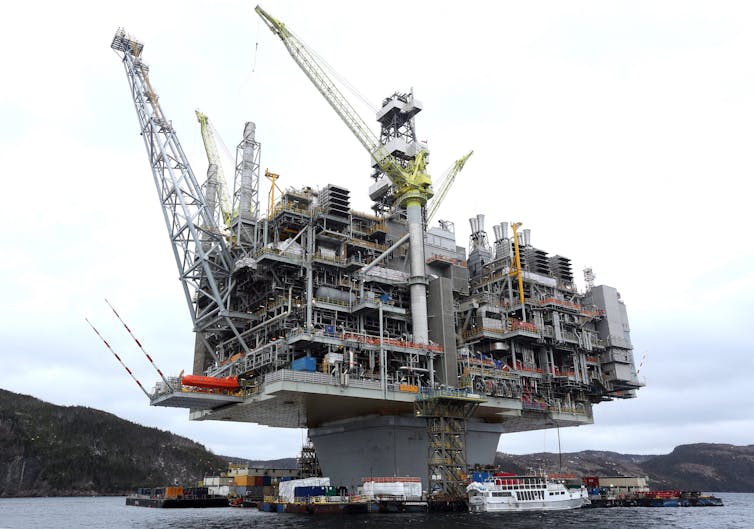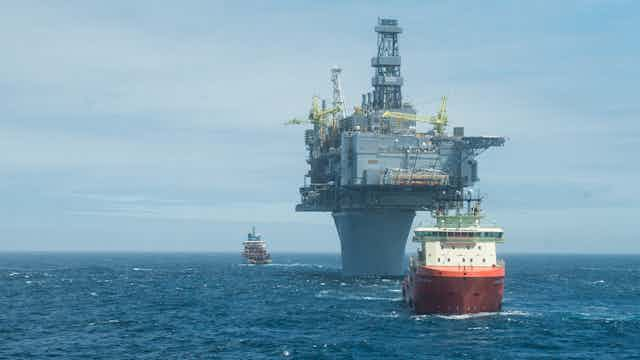Incredible feats of engineering and construction have been accomplished by Canadians throughout our history — the Confederation Bridge, the CN Tower, the transcontinental railway, Rideau Canal, the CANDU nuclear reactor and Canadarm, to name just a few.
Recently another impressive achievement was completed off the coast of Newfoundland, called Hebron. Based on my career experience as a mechanical engineer, I consider this massive offshore oil structure one of the most remarkable offshore wonders of the world and among the most impressive engineering accomplishments in Canada.
As the dean of engineering and applied science at Memorial University of Newfoundland, I am heartened that Memorial has contributed a significant role in ensuring the success of the Hebron offshore project.
Hebron’s 600,000-tonne concrete gravity-based structure (GBS) was a $14-billion project that involved more than 132,000 cubic metres of concrete produced and poured in its construction.
The base along the sea floor is 130 metres in diameter and has 52 well slots for offshore drilling.
Slip-forming of interior and exterior walls of the concrete pedestal to build up the huge structure, and progressively move it to deeper water in Bull Arm, NL, was an extraordinary challenge.
It involved a vast network of internal piping systems with a huge base slab. The topside structure, above the water line, is approximately 110 metres high. A sub-sea fibre optic cable, meantime, transmits information to an onshore support centre in St. John’s.

The unique design aspects of the Hebron include structural features that can withstand the harsh ocean conditions of the North Atlantic, extreme ocean waves often exceeding 20 to 25 metres in height, sea ice and icebergs.
The topsides are perched far beyond the central structure over the ocean that routinely produces freezing waves that continually slam into its underside.
In various ways, the designs of these undersides and central GBS were the first of their kind in the world. They required creative solutions to structural vibrations, stability, corrosion and ice impact.
The platform (GBS and topsides) reaches extremely high standards in terms of safety, durability and reliability of operations. The accomplishments are on par with the most complex offshore engineering structures ever conceived in the world.
Work moves below the ocean’s surface
As ocean surface conditions become increasingly harsh and restrictive as operations move further into new frontier regions of the North Atlantic, more development is moving below the surface and along the sea floor, where sub-sea engineering will have an ever-growing importance in terms of safety and reliability.
Moving a “factory” to the sea floor in a safe and environmentally responsible manner will be one of the 21st century’s most challenging and important technologies.
New sub-sea technologies are enabling longer distance pipelines along the sea floor to provide access to more remote locations. Sub-sea pipeline distances have increased from less than five kilometres to more than 10 in the past decade.
Researchers have developed new electrically heated pipe-in-pipe technology that enables tieback distances up to 40 kilometres from existing sub-sea facilities.
Role of engineering at Memorial
The Hebron structure positions Newfoundland and Labrador as a leader on the world stage in offshore technology development.
Memorial has had an active role. Through strategic initiatives like COASTS (Cold Ocean and Arctic Science, Technology and Society) and the OFI (Ocean Frontier Institute), Memorial is training a new generation of students working to ensure an environmentally responsible and economically vibrant offshore sector in the future.
The massive new Core Science Facility on Memorial’s campus boasts world-class science and engineering facilities. The Faculty of Engineering and Applied Science is also partnering with the offshore industry through its co-operative education model and innovative research. Hebron partners have supported Memorial’s engineering programs in various ways such as through student scholarships, research grants and co-op work terms.
With North America’s only co-op engineering program in ocean and naval architectural engineering, Memorial’s engineers have two years of co-op industry experience prior to graduation in order to tackle the complex challenges of future engineering mega-projects.
The school’s engineering researchers are also developing a range of technologies in support of safe and environmentally responsible development of offshore fields.
For example, new virtual environment simulation tools are being developed for training of offshore personnel to practise their skills in difficult emergency scenarios and improve offshore safety.
A research network called STePS2 developed more accurate predictive models for the operation of large ships and offshore structures in Arctic and ice-covered water.
With the help of Memorial’s contributions to the development and commercialization of these technologies, Newfoundland and Labrador is becoming a global leader in safely harnessing the vast potential of our cold ocean resources.
Environmental concerns
Responsible development of offshore resources presents important economic opportunities for Canada and elsewhere, but also environmental concerns. Memorial’s researchers are also tackling these concerns, such as advanced microbial biotechnologies to respond and mitigate against the risks of an accidental offshore oil spill.
A significant future prospect of offshore development in Newfoundland is called the Flemish Pass, where one of the world’s largest oil discoveries was made in 2013.
Nalcor Energy, the province’s Crown energy corporation, discovered four potential massive oil basins in the Labrador Sea. But depths of more than 1,000 metres in remote and harsh ocean conditions require the development of advanced subsea and digitalization technologies to ensure safer and more integrated operations.
Given that approximately a quarter of the world’s hydrocarbon resources are known to be located in the Arctic, the offshore and subsea technologies developed for Hebron will have an important role in future offshore developments in Canada and worldwide.

